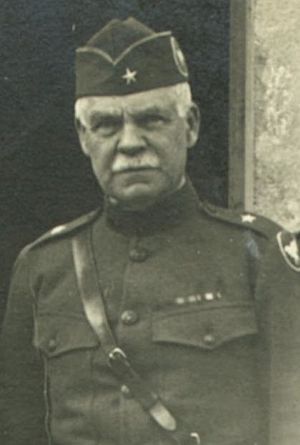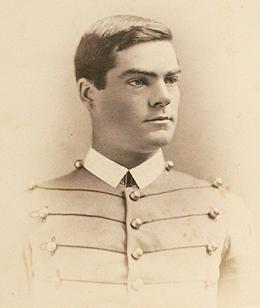George W. McIver facts for kids
Quick facts for kids
George W. McIver
|
|
|---|---|

McIver as commander of 161st Infantry Brigade, World War I
|
|
| Born | February 22, 1858 Carthage, North Carolina |
| Died | May 9, 1947 (aged 89) Washington, D.C. |
| Place of burial | |
| Allegiance | |
| Service/ |
|
| Years of service | 1882–1922 |
| Rank | |
| Commands held | U.S. Military Prison, Alcatraz Island School of Musketry Militia Bureau 161st Infantry Brigade 81st (Wildcat) Division Demobilization Group, Camp Pike, Arkansas Recruit Depot, Fort Slocum, New York |
| Battles/wars | American Indian Wars Spanish–American War World War I |
George W. McIver (February 22, 1858 – May 9, 1947) was an important United States Army officer. He rose to the rank of Brigadier General. McIver served as acting Chief of the Militia Bureau. He also commanded the 161st Infantry Brigade during World War I. His long career involved service in several major conflicts.
Contents
Early Life and Military Training
George Willcox McIver was born in Carthage, North Carolina, on February 22, 1858. He attended the University of North Carolina at Chapel Hill for a short time. Later, he graduated from the United States Military Academy in 1882. After graduating, he became a second lieutenant in the infantry.
McIver's first assignment was with the 17th Infantry Regiment. He served across the western United States during the American Indian Wars. This included postings at various forts. In 1885, he was part of a group sent to Rock Springs, Wyoming. They helped during unrest between miners there. He also took part in the Sioux Campaign from 1890 to 1891. From 1891 to 1893, he taught at West Point. Later, he advised the California National Guard.
Service in the Spanish–American War
In 1898, McIver joined the 7th Infantry again. He served in Cuba during the Spanish–American War. He fought in important battles like El Caney and San Juan Hill. These battles were key moments in the war.
After the Spanish–American War
After the war, McIver was stationed in different places. From 1898 to 1900, he was in Michigan and Minnesota. Then, from 1900 to 1901, he served in Alaska. He also worked on recruiting duty in Portland, Oregon, from 1901 to 1903.
He was assigned to the Philippines from 1903 to 1905. From 1905 to 1907, McIver was in charge of the U.S. Military prison on Alcatraz Island. He also helped build temporary homes in Golden Gate Park. These were for people affected by the 1906 San Francisco earthquake.
In 1907, he became the leader of the School of Musketry in Monterey, California. He helped publish the Army Small Arms Firing Manual. This manual taught soldiers how to use their weapons. He served in the Philippines again from 1912 to 1914. In 1915, McIver became an executive officer for the National Guard Bureau. He briefly served as acting Chief of the Militia Bureau in 1916.
World War I Leadership
In 1917, McIver was promoted to brigadier general. He took command of the 161st Brigade. This brigade was part of the 81st (Wildcat) Division. Most of the soldiers in this division were from North and South Carolina. They trained at camps in South Carolina.
McIver led his brigade in combat on the Western Front in France. They took part in the Meuse-Argonne Offensive. This was a very important battle. While leading the brigade, he also served as interim commander of the 81st Division several times. McIver was known for being more open-minded than some of his peers regarding race. He successfully integrated Lumbee and other Native American soldiers. He also believed that African-American soldiers could be good fighters.
At the end of World War I, McIver was suggested for a special award. However, it seems he did not receive the Distinguished Service Medal.
After World War I and Retirement
After the war, McIver returned to his permanent rank of colonel. From 1919 until his retirement in 1922, he held two commands. He first led the Demobilization Group at Fort Pike in Arkansas. Then he commanded the recruit depot at Fort Slocum, New York.
McIver lived in Washington, D.C., after he retired. In 1930, he was promoted to Brigadier General on the retired list. He passed away in Washington, D.C., on May 9, 1947. He is buried at Arlington National Cemetery.
Legacy
The George Willcox McIver Papers are kept at East Carolina University's Joyner Library. These papers contain important documents about his life. His autobiography, A Life of Duty, was published in 2006.


